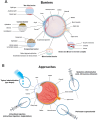Multifunctional nano-in-micro delivery systems for targeted therapy in fundus neovascularization diseases
- PMID: 38902775
- PMCID: PMC11191225
- DOI: 10.1186/s12951-024-02614-1
Multifunctional nano-in-micro delivery systems for targeted therapy in fundus neovascularization diseases
Abstract
Fundus neovascularization diseases are a series of blinding eye diseases that seriously impair vision worldwide. Currently, the means of treating these diseases in clinical practice are continuously evolving and have rapidly revolutionized treatment opinions. However, key issues such as inadequate treatment effectiveness, high rates of recurrence, and poor patient compliance still need to be urgently addressed. Multifunctional nanomedicine can specifically respond to both endogenous and exogenous microenvironments, effectively deliver drugs to specific targets and participate in activities such as biological imaging and the detection of small molecules. Nano-in-micro (NIM) delivery systems such as metal, metal oxide and up-conversion nanoparticles (NPs), quantum dots, and carbon materials, have shown certain advantages in overcoming the presence of physiological barriers within the eyeball and are widely used in the treatment of ophthalmic diseases. Few studies, however, have evaluated the efficacy of NIM delivery systems in treating fundus neovascular diseases (FNDs). The present study describes the main clinical treatment strategies and the adverse events associated with the treatment of FNDs with NIM delivery systems and summarizes the anatomical obstacles that must be overcome. In this review, we wish to highlight the principle of intraocular microenvironment normalization, aiming to provide a more rational approach for designing new NIM delivery systems to treat specific FNDs.
Keywords: Drug delivery; Fundus neovascular disease; Nano-in-micro (NIM) delivery system; Nanoparticles.
© 2024. The Author(s).
Conflict of interest statement
The authors declare no competing interests.
Figures







Similar articles
-
Recent Advances in Nanomedicine for Ocular Fundus Neovascularization Disease Management.Adv Healthc Mater. 2024 Jul;13(17):e2304626. doi: 10.1002/adhm.202304626. Epub 2024 Mar 10. Adv Healthc Mater. 2024. PMID: 38406994 Free PMC article. Review.
-
Surface engineered multifunctional nano-systems for localised drug delivery against thyroid cancer: A review of current practices.Biomed Pharmacother. 2024 Jul;176:116840. doi: 10.1016/j.biopha.2024.116840. Epub 2024 May 30. Biomed Pharmacother. 2024. PMID: 38820975 Review.
-
Multifunctional Nanocarriers for Alzheimer's Disease: Befriending the Barriers.Mol Neurobiol. 2024 May;61(5):3042-3089. doi: 10.1007/s12035-023-03730-z. Epub 2023 Nov 15. Mol Neurobiol. 2024. PMID: 37966683 Review.
-
Multifunctional nanoparticles for drug delivery and molecular imaging.Annu Rev Biomed Eng. 2013;15:253-82. doi: 10.1146/annurev-bioeng-071812-152409. Epub 2013 Apr 29. Annu Rev Biomed Eng. 2013. PMID: 23642243 Free PMC article. Review.
-
Nanoparticle delivery systems, general approaches, and their implementation in multiple myeloma.Eur J Haematol. 2017 Jun;98(6):529-541. doi: 10.1111/ejh.12870. Epub 2017 Mar 28. Eur J Haematol. 2017. PMID: 28208215 Free PMC article. Review.
Cited by
-
An exploration of the ocular mysteries linking nanoparticles to the patho-therapeutic effects against keratitis.J Nanobiotechnology. 2025 Mar 6;23(1):184. doi: 10.1186/s12951-025-03230-3. J Nanobiotechnology. 2025. PMID: 40050881 Free PMC article. Review.
-
External stimuli-responsive drug delivery to the posterior segment of the eye.Drug Deliv. 2025 Dec;32(1):2476140. doi: 10.1080/10717544.2025.2476140. Epub 2025 Mar 24. Drug Deliv. 2025. PMID: 40126105 Free PMC article. Review.
-
Nanoparticle and microparticle-based systems for enhanced oral insulin delivery: A systematic review and meta-analysis.J Nanobiotechnology. 2024 Dec 29;22(1):802. doi: 10.1186/s12951-024-03045-8. J Nanobiotechnology. 2024. PMID: 39734205 Free PMC article.
-
Recent advances in engineered exosome-based therapies for ocular vascular disease.J Nanobiotechnology. 2025 Jul 19;23(1):526. doi: 10.1186/s12951-025-03589-3. J Nanobiotechnology. 2025. PMID: 40684186 Free PMC article. Review.
-
A comprehensive review of unlocking the potential of lignin-derived biomaterials: from lignin structure to biomedical application.J Nanobiotechnology. 2025 Jul 24;23(1):538. doi: 10.1186/s12951-025-03604-7. J Nanobiotechnology. 2025. PMID: 40707932 Free PMC article. Review.
References
-
- Wu MX, Yang YW. Metal–Organic Framework (MOF)-Based Drug/Cargo Delivery and Cancer Therapy. Adv Mater 2017, 29. - PubMed
-
- Jin Y, Guo Y, Yang J, Chu X, Huang X, Wang Q, Zeng Y, Su L, Lu S, Wang C et al. A Novel Inside-Out intraocular nanomedicine Delivery Mode for nanomaterials’ Biological Effect enhanced Choroidal neovascularization occlusion and Microenvironment Regulation. Adv Mater 2023, 35. - PubMed
-
- Guo B, Yang F, Zhang L, Zhao Q, Wang W, Yin L, Chen D, Wang M, Han S, Xiao H, Xing N. Cuproptosis Induced by ROS responsive nanoparticles with Elesclomol and Copper Combined with αPD-L1 for enhanced Cancer Immunotherapy. Adv Mater 2023, 35. - PubMed
Publication types
MeSH terms
Grants and funding
- 2023028/Chengdu Medical Scientific Research Project
- 2022282/Chengdu Medical Scientific Research Project
- 2023PI23/The Third People's Hospital of Chengdu Scientific Research Project
- 2022-YF05-01861-SN/Chengdu Science and Technology Bureau's technology innovation research and development project
- KY2023QN0014/Youth Project of Sichuan Medical and Health Promotion Association
LinkOut - more resources
Full Text Sources

